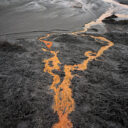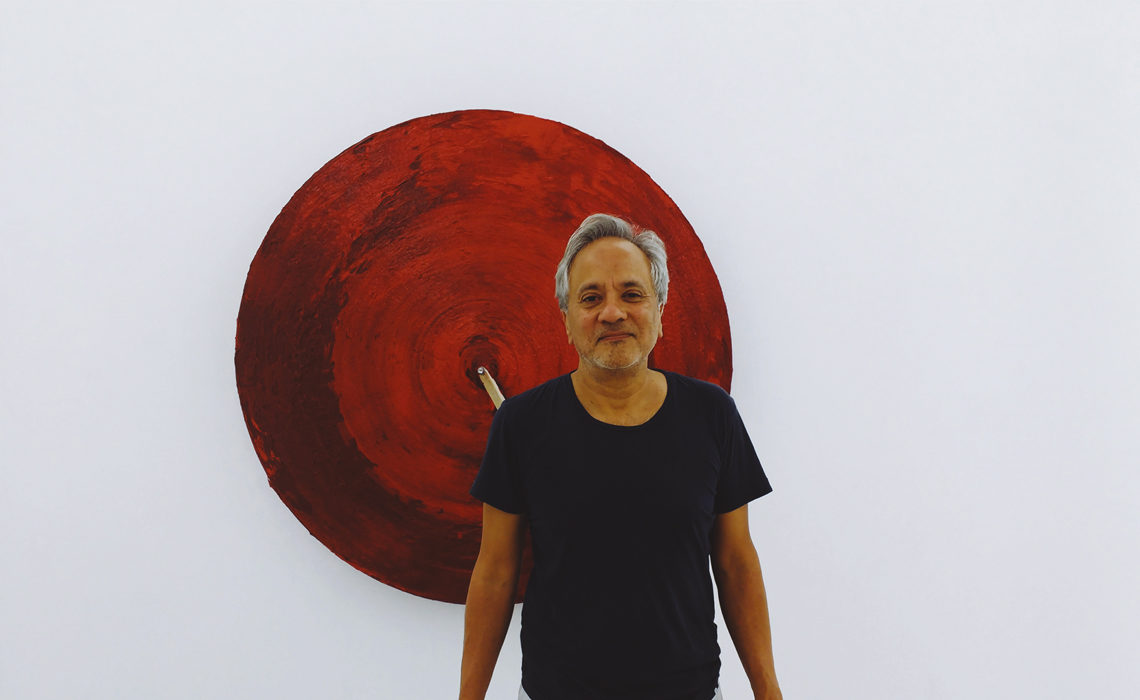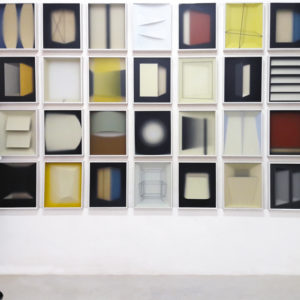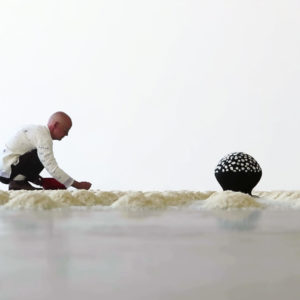L’arte non si realizza, l’arte accade. Ne è convinto Anish Kapoor, scultore tra i più acclamati del nostro tempo, che ha fatto del suo percorso artistico un cammino di scoperta e consapevolezza. La sua ricerca inizia a Londra, negli anni ‘70. È qui che Kapoor, nato a Bombay nel 1954, si trasferisce per studiare arte. Da straniero, anela a qualcosa di universale, che attingendo ad archetipi condivisi, gli restituisca un senso di appartenenza. Sui banchi di scuola scopre Marcel Duchamp e le sue macchine celibi, riformulando l’idea che tutto possa essere arte in una nuova accezione: tutto può essere simbolo, un codice poetico che l’artista è chiamato a interpretare. Un altro incontro decisivo è quello con Paul Neàgu, che lo introduce al mondo delle installazioni e dell’Arte povera degli anni ‘60.
Ma Kapoor non è ancora pronto a far sentire la sua voce, deve prima capire chi è. Un viaggio in India nel ‘79 gli apre gli occhi, mettendolo di fronte alla sua extraterritorialità, una scissione interiore che lo porterà sempre a danzare tra gli opposti: oriente e occidente, realtà e illusione, buio e luce. Quest’epifania confluisce nella sua prima opera importante: 1000 names, una serie di oggetti cosparsi di pigmenti colorati, gli stessi venduti fuori dai templi indiani a uso cosmetico o rituale. Le forme indefinite, a metà tra il mondo naturale e quello astratto, appartengono a corpi in transizione, che sembrano scaturire dalla materia, e così facendo irradiano una straordinaria energia. Attraverso il colore che sborda e deforma gli oggetti, Kapoor compie qui, per la prima volta, il gesto che connoterà la sua intera parabola artistica: manipolare la percezione di chi osserva. Ciò che è non è ciò che sembra. L’incertezza coltivata negli occhi dello spettatore fa il paio con quella dell’artista, che nell’avviare un’opera non sa mai davvero cosa succederà.
Già nel 1980, quando Kapoor espone per la prima volta, a Parigi, la rotta del suo viaggio è chiara. Rimbalzando tra bidimensionalità e tridimensionalità, l’artista si guadagna subito un posto di spicco nella New British Sculpture, tra nomi come Tony Cragg e Antony Gormley. Dopo la sua prima mostra personale a Londra nel 1981, seguono anni di grande fermento, in cui le forme, inizialmente contenute, cominciano a lievitare. Nascono così sculture sempre più monumentali, cui è affidato il compito di incarnare il vuoto, reso tangibile da una cavità che si colma o dalla materia che si oblitera. A inaugurare il nuovo corso è Void Field, che Kapoor crea per la Biennale di Venezia del 1990. Chiamato a rappresentare la Gran Bretagna sebbene sia ancora cittadino indiano, lo scultore illustra questa dicotomia combinando pietra inglese e pigmento indiano. Sul pavimento dispone sedici blocchi di arenaria forati e riempiti di polvere nera, a evocare un grembo materno, cui non si può tornare. Il tema dell’origine e del femminile offre una sponda ideale al concetto del vuoto quale spazio potenziale, e si traduce in riferimenti come cavità uterine, rigonfiamenti gravidi, fessure da cui si intravede la vertigine del mistero. Ne è un esempio Madonna (1989-90), un disco sospeso, innervato da una forza ipnotica, di cui non si può intuire la profondità, a meno di non allungare la mano e “profanare” l’opera. Il rimando alla gestazione si fa esplicito in When I am Pregnant (1992), protuberanza in fibra di vetro che emerge da una parete bianca, assumendo contorni diversi a seconda del punto da cui la si guarda. Scavato nel muro è invece Yellow (1999), un sole vorace che sembra voler risucchiare l’intera stanza. Concave o convesse, le forme di Kapoor hanno sempre qualcosa di ineffabile, un’essenza criptica che gravita attorno all’agognato vuoto. Lì dove il tempo e lo spazio vengono azzerati, si spalanca l’ebbrezza del possibile. Ciò che ancora non è, ciò che non si comprende, fa paura, ma solo attraversando il vuoto si può avanzare lungo il cammino della consapevolezza.
Il cammino di Kapoor dagli anni ‘90 in poi è costellato di allori. Alla Biennale di Venezia gli viene conferito il Premio Duemila, seguito nel 1991 dal Turner Prize. Istituzioni e musei si contendono le sue opere: da Milano a Tokyo, da Napoli a New York. Mentre lui continua a vivere e lavorare in Inghilterra, il mondo scopre le sue illusioni ottiche e ne resta folgorato. Installazioni come C-Curve, Turning the World Upside Down o Suck testimoniano con sempre maggiore potenza il suo talento nel confondere i sensi, avvalendosi di superfici riflettenti per distorcere la realtà. Emblematico è Sky Mirror, un immenso disco di metallo concavo e specchiato, realizzato in più versioni ed esposto in vari angoli del globo: un non-oggetto che muta con le ore del giorno e si fonde con l’ambiente. Lo stesso intento mimetico caratterizza Cloud Gate, l’imponente “fagiolo” d’acciaio che di Kapoor è l’opera più nota. Eretta tra il 2004 e il 2006 nel Millennium Park di Chicago, la scultura si tende come un arco tra la terra e il cielo, catturando il paesaggio urbano sulla sua pelle lucida. È un totem che occupa spazio, ma al contempo “crea” spazio. L’apice di questo percorso incentrato sul gioco della percezione si tocca con Leviathan, titanica installazione alta 33 metri e larga 100, che nel 2011 piomba all’ingresso del Grand Palais di Parigi come un pallone caduto dal cielo. Entrare nel ventre infuocato del mostro è come sprofondare in una caverna pulsante di luci e colori, un’esperienza che inebria e travolge.
In contrasto con l’enormità di Leviathan, negli stessi anni Kapoor riporta l’attenzione sul piccolo, inteso come grumo o frammento strappato alla materia. È il caso di Shooting into the Corner (2008), un minaccioso cannone che ogni 20 minuti spara proiettili rossi in una stanza. Schiantandosi contro il muro, questi esplodono, evocando l’immagine orrorifica di corpi maciullati, dinanzi a cui è impossibile restare indifferenti. Qui Kapoor usa la cera, altre volte sperimenta con il marmo, il calcare, il PVC, per plasmare oggetti geometrici o biomorfi, piccoli o grandi. Cambiano le forme e i materiali, restano i colori: il blu della spiritualità, il rosso della sensualità, e poi la luce, che sembra sgorgare direttamente dall’interno delle cose. Ma se Kapoor è il poeta degli opposti, allora non può esserci luce senza ombra.
L’oscurità è la porta del mistero, un abisso in cui lui vuole costringerci a guardare. E per questo non basta il nero, ci vuole qualcosa che sia la negazione stessa del colore, come il Vantablack, pigmento di cui detiene il monopolio. Ideato a fini militari per verniciare i velivoli stealth, invisibili ai radar, questo non-colore è talmente scuro da assorbire il 99,9% della luce, annullando così ogni percezione di tempo e spazio. Scolpire “buchi neri”: ecco cosa Kapoor punta a fare nel prossimo futuro. È la catarsi definitiva, l’apoteosi di quel vuoto fecondo che da sempre insegue, per penetrare il mistero e approdare alla consapevolezza.
Art cannot be realized, art happens. This is the belief of Anish Kapoor, sculptor among the most acclaimed of our times, who made of his artistic growth a journey of discovery and awareness. His research begins in London, during the 1970s. It is there that Kapoor, born in Mumbai in 1954, moves to study art. As a foreigner, he yearns for something universal, which, drawing on shared archetypes, could give him back a sense of belonging. At school, he discovers Marcel Duchamp and his bachelor machines, reformulating the idea that anything can be art under a new meaning: anything can be symbol, a poetic code that the artist is called to interpret. Another fateful meeting is the one with Paul Neàgu, who introduces him to the world of installations and “Arte povera”
of the 1960s.
Kapoor, however, is still not ready to make his voice be heard, he must first understand who he is. A voyage to India in 1979 opens his eyes, making him face his extraterritoriality, an inner division that will always lead him dancing between opposites: east and west, reality and illusion, darkness and light. This epiphany contributes to his first important piece: 1000 names, a series of objects scattered with colored pigments, the same pigments that are sold outside Indian temples, for cosmetic or ritual use. The undefined shapes, halfway between the natural and abstract worlds, belong to transitioning bodies, that seems to be born from matter, irradiating, this way, an extraordinary energy. Through the color, which overflows and deforms objects, Kapoor performs here, for the first time, the act that will characterize his entire artistic parabola: he manipulates the perception of the audience. What is is not what it looks like. The uncertainty cultivated in the eyes of the audience doubles the uncertainty of the artist, who, in beginning a piece, does never actually now what will happen.
Already in 1980, when Kapoor exhibits for the first time, in Paris, the route of his journey is clear. Spreading between bi-dimensionality and three-dimensionality, the artist quickly earns a leading place in the new British Sculpture, among names such as Tony Cragg and Antony Gormley. After his first personal exhibition in London in 1981, years of great excitement soon follows, where the initially contained forms begin to expand. New sculptures, more and more monumental are born, their goal to incarnate the void, made tangible by a filled cavity or by obliterating matter. This new development is inaugurated by Void Field, which Kapoor creates for the Venice Biennale of 1990. Invited to represent Great Britain, even though he is still an Indian citizen, the sculptor, illustrates this dichotomy combining English stone and Indian pigment. On the floor he lays sixteen blocks of pierced sandstone, filled with black powder, in order to evoke the maternal womb, where it is impossible to return. The theme or origin and femininity offers an ideal back-up to the concept of void as potential space, and it translates into references such as uterine cavities, pregnant swellings, fissures from which we can glimpse the vertigo of mystery. An example of this is Madonna (1989-90), a suspended disc, innervated by a hypnotic strength, of which we cannot discern its depth, unless we reach out with our hand and “desecrate” the piece. The reference to pregnancy is explicit in When I am Pregnant (1992), a voracious sun that seems to devour the entire room. Concave or convex, Kapoor’s shapes have always something inexpressible, a cryptic essence that revolve around the coveted emptiness. Where time and space are deleted, the intoxication of possibility is revealed. What is not yet, what cannot be understood, scares us, and yet only by crossing the void we can advance along the path of awareness.
Kapoor’s journey in the 1990s is studded with success. At the Venice Biennale he is awarded with the Duemila Prize, followed in 1992 by the Turner Prize. Institutions and museums compete for his pieces: from Milan to Tokyo, from Naples to New York. While he continues living and working in England, the world discovers his optical illusions and the is struck by them. Installations such as C-Curve, Turning The World Upside Down or Suck testify with an ever growing strength his talent in confounding the senses; by using reflecting surfaces to bend reality. Emblematic is Sky Mirror, a gigantic metal disc, concave and mirrored, realized in several version and displayed in various parts of the world: a non-object that transforms with the hours of the day and blends with the environment. The same mimetic goal characterizes Cloud Gate, the imposing steel “bean”, Kapoor’s most famous piece. Realized between 2004 and 2006 in Millenium Park in Chicago, the sculpture stretches out as archway between land and sky, capturing the urban landscape on its lucid surface. A totem that occupies space, but that at the same time “creates” space. The apex of this journey centered on perception is reached with Leviathan, in the same years Kapoor brings back the attention on the small, meant as clump or fragment torn from matter. It is the case with Shooting into the Corner (2008), a menacing cannon that every 20 minutes shoots red bullets in a room. Crashing onto the wall, the bullets explode, evoking the horrifying image of mangled bodies, an image before which it is impossible to remain indifferent. Here Kapoor uses wax, other times he experiments with marble, limestone, PVC, to create geometric or organic-shaped object, small or large. Shapes and materials change, but the colors remain the same: the blue of spirituality, the red of sensuality, and then light, that seems to pour directly from the inside of things. But if Kapoor is the poet of opposites, then there cannot be light without shadows.
Darkness is the door to the unknown, an abyss he forces us to investigate. And for this, black is not enough, he needs something that is the opposite of color itself, like the Vantablack, a pigment on which he has the monopoly. Created for military use, to paint the stealth vehicles, undetected by radars, this non-color is so dark it absorbs the 99,9% of light, nullifying every perception of time and space. Sculpting “black holes”: this is what Kapoor aims at for the future. The ultimate catharsis, the apotheosis of that fertile void that he has always been chasing, to seep through the mystery and reach awareness.








No Comments